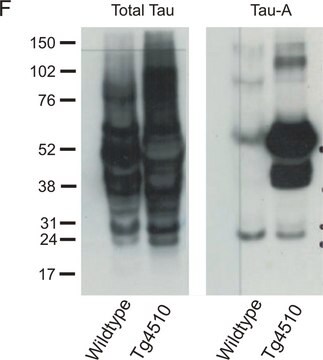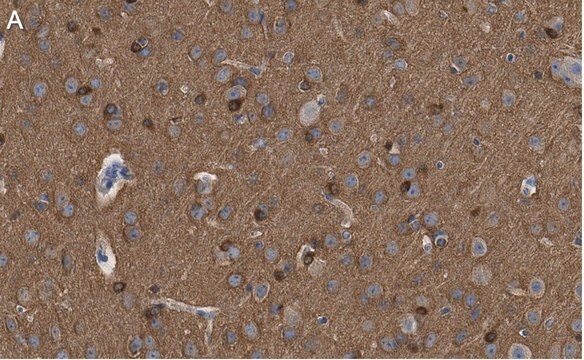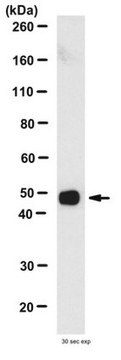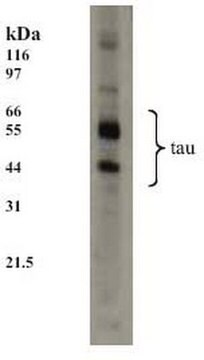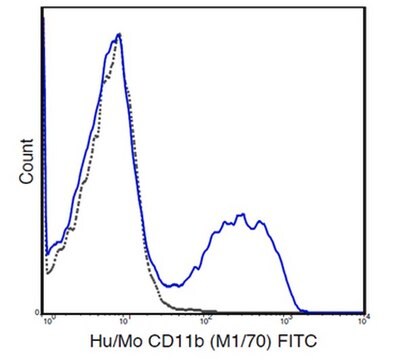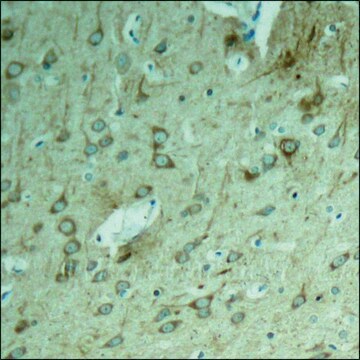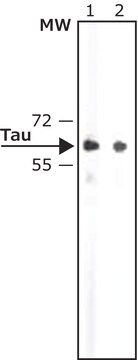推荐产品
生物源
mouse
抗體表格
purified immunoglobulin
抗體產品種類
primary antibodies
無性繁殖
2A1-2E1, monoclonal
物種活性
mouse, human
包裝
antibody small pack of 25 μg
技術
immunohistochemistry: suitable
western blot: suitable
同型
IgG2aκ
NCBI登錄號
UniProt登錄號
目標翻譯後修改
unmodified
基因資訊
human ... MAPT(4137)
mouse ... Mapt(17762)
一般說明
Microtubule-associated protein tau (UniProt: P10636; also known as Neurofibrillary tangle protein, Paired helical filament-tau, PHF-tau) is encoded by the MAPT (also known as MAPTL, MTBT1, TAU) gene (Gene ID: 4137) in human. Microtubule-associated protein tau is shown to be expressed in neurons. It is mostly found in axons, in the cytosol, and in association with plasma membrane components. Isoform PNS-tau is expressed in the peripheral nervous system while the others are expressed in the central nervous system. Nine isoforms of Tau have been described that are generated by alternative splicing. Tau proteins promote microtubule assembly and stability, and may also be involved in the establishment and maintenance of neuronal polarity. The C-terminus binds axonal microtubules while the N-terminus binds neural plasma membrane components, thus serving as a linker protein between both. The short isoforms are reported to allow plasticity of the cytoskeleton whereas the longer isoforms may preferentially play a role in its stabilization. In Alzheimer disease (AD), the neuronal cytoskeleton in the brain is progressively disrupted and replaced by tangles of paired helical filaments (PHF) and straight filaments, mainly composed of hyperphosphorylated forms of Tau. In AD brain Tau accumulates in both the somatodendritic and axonal domains of neurons and it also accumulates in the soma as neurofibrillary tangles (NFTs). Tau oligomers are reported to be neurotoxic when applied extracellularly to cultured neuronal cells and can induce neurodegeneration and synaptic and mitochondrial dysfunction in vivo.
特異性
Clone 2A1-2E1 detects Microtubule-associated protein tau in human and murine brain. It targets an epitope within 19 amino acids from the N-termnal half.
免疫原
KLH-conjugated linear peptide corresponding to 19 amino acids from the N-terminal half of human Microtubule-associated protein tau.
應用
Anti-Tau, clone 2A1-2E1, Cat. No. MABN2472, is a highly specific mouse monoclonal antibody that targets Microtubule-associated protein tau and has been tested for use in Immunohistochemistry and Western Blotting.
Research Category
Neuroscience
Neuroscience
Western Blotting Analysis: A representative lot detected Tau in Western Blotting applications (Ishigaki, S., et. al. (2017). Cell Rep. 18(5):1118-1131).
Immunohistochemistry Analysis: A representative lot detected Tau in Immunohistochemistry applications (Ishigaki, S., et. al. (2017). Cell Rep. 18(5):1118-1131).
Immunohistochemistry Analysis: A representative lot detected Tau in Immunohistochemistry applications (Ishigaki, S., et. al. (2017). Cell Rep. 18(5):1118-1131).
品質
Evaluated by Western Blotting in human Tau-441 recombinant protein lysates.
Western Blotting Analysis: 2 µg/mL of this antibody detected Tau in human Tau-441 recombinant protein lysates.
Western Blotting Analysis: 2 µg/mL of this antibody detected Tau in human Tau-441 recombinant protein lysates.
標靶描述
~70 kDa observed; 78.93 kDa calculated. Uncharacterized bands may be observed in some lysate(s).
外觀
Protein G purified
Format: Purified
Purified mouse monoclonal antibody IgG2a in buffer containing 0.1 M Tris-Glycine (pH 7.4), 150 mM NaCl with 0.05% sodium azide.
儲存和穩定性
Stable for 1 year at 2-8°C from date of receipt.
其他說明
Concentration: Please refer to lot specific datasheet.
免責聲明
Unless otherwise stated in our catalog or other company documentation accompanying the product(s), our products are intended for research use only and are not to be used for any other purpose, which includes but is not limited to, unauthorized commercial uses, in vitro diagnostic uses, ex vivo or in vivo therapeutic uses or any type of consumption or application to humans or animals.
未找到合适的产品?
试试我们的产品选型工具.
儲存類別代碼
12 - Non Combustible Liquids
水污染物質分類(WGK)
WGK 1
我们的科学家团队拥有各种研究领域经验,包括生命科学、材料科学、化学合成、色谱、分析及许多其他领域.
联系技术服务部门